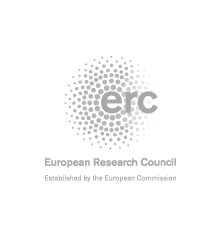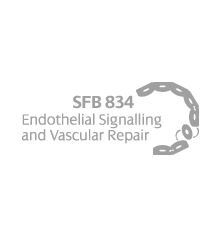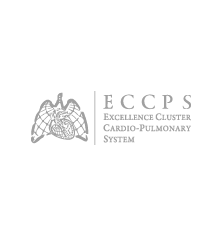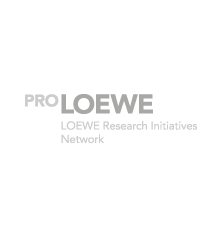General research interests
Our research is centred on blood vessels, particularly the regulation of blood vessel growth (angiogenesis) by metabolism. Angiogenesis and metabolism are tightly coupled as blood vessels supply nutrients and oxygen to energy-consuming tissues (e.g. brain, heart or skeletal muscle). A reduction in tissue oxygen tension or nutrient availability is a primary stimulus for angiogenesis, which prompts endothelial cells (ECs) to become motile, invasive and to form new vessel connections. We study how ECs sense such environmental signals and how they use this information to build vascular networks of organ-specific size, shape and density. We are also interested in the metabolism of ECs, aiming to understand how endothelial metabolic state controls vessel growth and function, and how deregulation contributes to disease.
Regulation of endothelial metabolism
Angiogenesis is a dynamic process that involves the specification of ECs into tip and stalk cells, their directed migration and proliferation, as well as the formation of new connections (Potente et al., 2011). The primary focus of angiogenesis research has been the understanding of mechanisms that induce such endothelial phenotypes, work that has led to the identification of signalling pathways that control EC migration and proliferation. But the adoption of an angiogenic phenotype has significant consequences for endothelial metabolism as well, a link that has been widely ignored previously. This concept stems from the premise that ECs have to meet the bioenergetic demands of increased proliferation when they switch from quiescence to vessel growth. Indeed, proliferating cells require nutrients, energy, and biosynthetic activity to produce the building blocks (e.g. nucleotides, amino acids, lipids) for cell duplication. During angiogenesis, ECs, thus, have to rewire their metabolism to generate energy quickly and to facilitate the incorporation of nutrients into biomass. However, the mechanisms that balance endothelial metabolic activity and growth state are not known to date.
In our research program, we focus on transcriptional mechanisms that regulate endothelial metabolism during physiological and pathological vascular growth. We are particularly interested in the forkhead box O (FOXO) family of transcription factors, which have been shown to control cell proliferation, metabolism, and stress resistance (Oellerich and Potente, 2012). FOXOs are key transcriptional effectors of the PI3K / AKT pathway that coordinates growth and metabolism in normal and cancer cells. PI3K signalling inhibits FOXO activity through AKT-mediated phosphorylation leading to the exclusion of FOXOs from the nucleus. Previous work from our laboratory has shown that FOXOs suppress endothelial angiogenic behaviour in surrogate assays of angiogenesis (Potente et al., 2005). However, the specific cellular functions of FOXOs in angiogenesis in vivo remain unclear. We use a combination of genetic, biochemical and imaging technologies to define the role of individual FOXO family members for endothelial growth and metabolism in models of vascular development, homeostasis and disease.
Endothelial metabolic sensors
Oxygen deprivation (hypoxia) is a critical stimulus for ECs to form new vessel branches. However, hypoxia is also associated with severe metabolic stress. ECs that invade hypoxic tissues face not only the challenge of meeting the bioenergetic demands of enhanced proliferation, but also the challenge of surviving fluctuations in oxygen availability. ECs, therefore, need to be equipped with a metabolic machinery that allows growth in hypoxic microenvironments. The metabolism of ECs is indeed different from other differentiated cells. Angiogenic ECs preferentially use glycolysis over mitochondrial oxidative phosphorylation (OXPHOS) for ATP generation. Glycolysis is an inefficient way to generate ATP, yet it enables ECs to make ATP faster and at greater quantities if glycolytic flux is accelerated. In addition to energy production, glycolysis diverts metabolic intermediates into biosynthetic pathways to produce the building blocks for proliferation. Even in the presence of ample oxygen (that fuels mitochondrial respiration in other cell types), ECs are glycolytic (“aerobic glycolysis”). This metabolic behaviour reduces endothelial oxygen consumption and ensures efficient oxygen delivery to perivascular tissues. In hypoxic conditions, ECs use glycolysis anaerobically (“anaerobic glycolysis”), which allows them to grow in conditions that kill other types of cells. Together, these considerations suggest that ECs actively sense their metabolic microenvironment to adapt behaviour to oxygen and nutrient availability. The molecular nature of these sensing mechanisms in ECs is however not well understood.
Our laboratory is interested to identify such metabolic sensors. Previously, we have studied the role of SIRT1 in this context. SIRT1 is a protein deacetylase that requires the metabolic cofactor NAD+ for its catalytic activity and is, thus, coupled to the metabolic state of the cell (Oellerich and Potente, 2012). Genetic inactivation of SIRT1 impairs the ability of ECs to form new vessel branches, particularly in response to oxygen and nutrient deprivation (Potente et al., 2007). The deregulated angiogenic behaviour is, in part, caused by unrestrained activity of the endothelial Notch pathway, which we identified as a critical target of SIRT1 in ECs (Guarani et al., 2011). SIRT1, itself regulated by the metabolic state of the cell, might, therefore, function as a sensor coupling tissue oxygenation and nutritional supply to Notch-dependent control of branching vessel morphogenesis.
Vessel size and shape control
The shape, size and density of the vasculature is intimately linked to the metabolic demands of the tissues it serves. Newly formed vessel networks, therefore, need to remodel to adjust vessel architecture to organ function (Potente et al., 2011). In contrast to the extensive literature on how vessels sprout, branch and elongate, very little is known about the molecular determinants of vascular remodelling. A central goal of our laboratory is to uncover transcriptional regulators that drive this remodelling process in normal and disease conditions.
A hallmark of remodelling is vascular pruning through selected branch regression. Blood flow is a critical parameter that determines whether a vessel persists or regresses (Potente et al., 2011). However, the molecular mechanisms that determine whether a branch is selected for regression remain poorly understood. Another critical step of vascular remodelling is the transition from a small capillary-like vessel, with only few ECs, into larger tubes with many ECs. This increase in vessel size (diameter) is critical for tissue perfusion as it enables adequate flow towards the peripheral capillary bed. Not surprisingly, EC proliferation is a crucial determinant of such circumferential expansion and defects in the proliferative capacity of ECs can have striking effects on vessel size. Though a number of signalling molecules have been implicated in governing endothelial proliferation, little is known about endogenous mechanisms that sense vessel size or provide information about cell density in the endothelial lining. It is also unclear how such “tissue-size checkpoints” are regulated, and relay needs for vessel expansion or regression to the endothelium.
References
Guarani, V., Deflorian, G., Franco, C.A., Kruger, M., Phng, L.K., Bentley, K., Toussaint, L., Dequiedt, F., Mostoslavsky, R., Schmidt, M.H., et al. (2011). Acetylation-dependent regulation of endothelial Notch signalling by the SIRT1 deacetylase. Nature 473, 234-238.
Oellerich, M.F., and Potente, M. (2012). FOXOs and sirtuins in vascular growth, maintenance, and aging. Circulation Research 110, 1238-1251.
Potente, M., Gerhardt, H., and Carmeliet, P. (2011). Basic and therapeutic aspects of angiogenesis. Cell 146, 873-887.
Potente, M., Ghaeni, L., Baldessari, D., Mostoslavsky, R., Rossig, L., Dequiedt, F., Haendeler, J., Mione, M., Dejana, E., Alt, F.W., et al. (2007). SIRT1 controls endothelial angiogenic functions during vascular growth. Genes & Development 21, 2644-2658.
Potente, M., Urbich, C., Sasaki, K., Hofmann, W.K., Heeschen, C., Aicher, A., Kollipara, R., DePinho, R.A., Zeiher, A.M., and Dimmeler, S. (2005). Involvement of Foxo transcription factors in angiogenesis and postnatal neovascularization. The Journal of Clinical Investigation 115, 2382-2392.


















